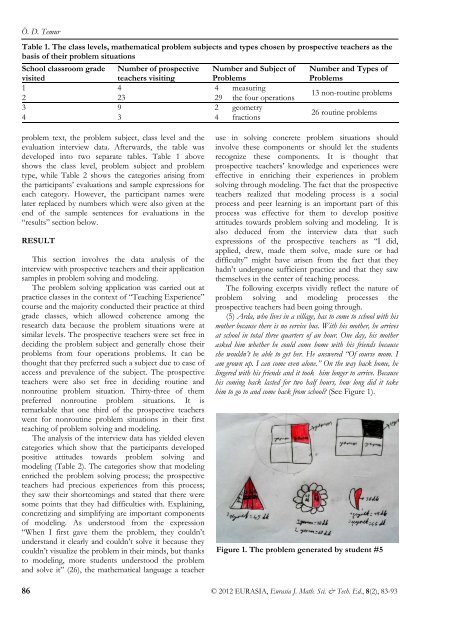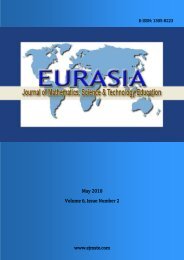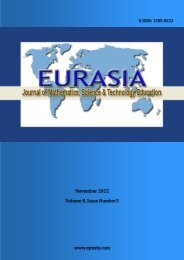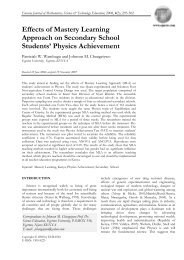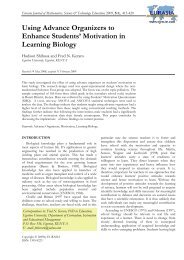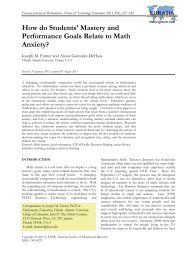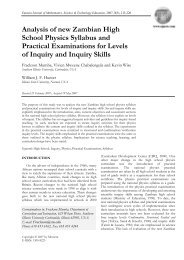Teaching of Mathematical Modeling and Problem Solving
Teaching of Mathematical Modeling and Problem Solving
Teaching of Mathematical Modeling and Problem Solving
Create successful ePaper yourself
Turn your PDF publications into a flip-book with our unique Google optimized e-Paper software.
Ö. D. Temur<br />
Table 1. The class levels, mathematical problem subjects <strong>and</strong> types chosen by prospective teachers as the<br />
basis <strong>of</strong> their problem situations<br />
School classroom grade<br />
visited<br />
Number <strong>of</strong> prospective<br />
teachers visiting<br />
Number <strong>and</strong> Subject <strong>of</strong><br />
<strong>Problem</strong>s<br />
1 4 4 measuring<br />
2 23 29 the four operations<br />
3 9 2 geometry<br />
4 3 4 fractions<br />
Number <strong>and</strong> Types <strong>of</strong><br />
<strong>Problem</strong>s<br />
13 non-routine problems<br />
26 routine problems<br />
problem text, the problem subject, class level <strong>and</strong> the<br />
evaluation interview data. Afterwards, the table was<br />
developed into two separate tables. Table 1 above<br />
shows the class level, problem subject <strong>and</strong> problem<br />
type, while Table 2 shows the categories arising from<br />
the participants’ evaluations <strong>and</strong> sample expressions for<br />
each category. However, the participant names were<br />
later replaced by numbers which were also given at the<br />
end <strong>of</strong> the sample sentences for evaluations in the<br />
“results” section below.<br />
RESULT<br />
This section involves the data analysis <strong>of</strong> the<br />
interview with prospective teachers <strong>and</strong> their application<br />
samples in problem solving <strong>and</strong> modeling.<br />
The problem solving application was carried out at<br />
practice classes in the context <strong>of</strong> “<strong>Teaching</strong> Experience”<br />
course <strong>and</strong> the majority conducted their practice at third<br />
grade classes, which allowed coherence among the<br />
research data because the problem situations were at<br />
similar levels. The prospective teachers were set free in<br />
deciding the problem subject <strong>and</strong> generally chose their<br />
problems from four operations problems. It can be<br />
thought that they preferred such a subject due to ease <strong>of</strong><br />
access <strong>and</strong> prevalence <strong>of</strong> the subject. The prospective<br />
teachers were also set free in deciding routine <strong>and</strong><br />
nonroutine problem situation. Thirty-three <strong>of</strong> them<br />
preferred nonroutine problem situations. It is<br />
remarkable that one third <strong>of</strong> the prospective teachers<br />
went for nonroutine problem situations in their first<br />
teaching <strong>of</strong> problem solving <strong>and</strong> modeling.<br />
The analysis <strong>of</strong> the interview data has yielded eleven<br />
categories which show that the participants developed<br />
positive attitudes towards problem solving <strong>and</strong><br />
modeling (Table 2). The categories show that modeling<br />
enriched the problem solving process; the prospective<br />
teachers had precious experiences from this process;<br />
they saw their shortcomings <strong>and</strong> stated that there were<br />
some points that they had difficulties with. Explaining,<br />
concretizing <strong>and</strong> simplifying are important components<br />
<strong>of</strong> modeling. As understood from the expression<br />
“When I first gave them the problem, they couldn’t<br />
underst<strong>and</strong> it clearly <strong>and</strong> couldn’t solve it because they<br />
couldn’t visualize the problem in their minds, but thanks<br />
to modeling, more students understood the problem<br />
<strong>and</strong> solve it” (26), the mathematical language a teacher<br />
use in solving concrete problem situations should<br />
involve these components or should let the students<br />
recognize these components. It is thought that<br />
prospective teachers’ knowledge <strong>and</strong> experiences were<br />
effective in enriching their experiences in problem<br />
solving through modeling. The fact that the prospective<br />
teachers realized that modeling process is a social<br />
process <strong>and</strong> peer learning is an important part <strong>of</strong> this<br />
process was effective for them to develop positive<br />
attitudes towards problem solving <strong>and</strong> modeling. It is<br />
also deduced from the interview data that such<br />
expressions <strong>of</strong> the prospective teachers as “I did,<br />
applied, drew, made them solve, made sure or had<br />
difficulty” might have arisen from the fact that they<br />
hadn’t undergone sufficient practice <strong>and</strong> that they saw<br />
themselves in the center <strong>of</strong> teaching process.<br />
The following excerpts vividly reflect the nature <strong>of</strong><br />
problem solving <strong>and</strong> modeling processes the<br />
prospective teachers had been going through.<br />
(5) Arda, who lives in a village, has to come to school with his<br />
mother because there is no service bus. With his mother, he arrives<br />
at school in total three quarters <strong>of</strong> an hour. One day, his mother<br />
asked him whether he could come home with his friends because<br />
she wouldn’t be able to get her. He answered “Of course mom. I<br />
am grown up. I can come even alone.” On the way back home, he<br />
lingered with his friends <strong>and</strong> it took him longer to arrive. Because<br />
his coming back lasted for two half hours, how long did it take<br />
him to go to <strong>and</strong> come back from school? (See Figure 1).<br />
Figure 1. The problem generated by student #5<br />
86 © 2012 EURASIA, Eurasia J. Math. Sci. & Tech. Ed., 8(2), 83-93


